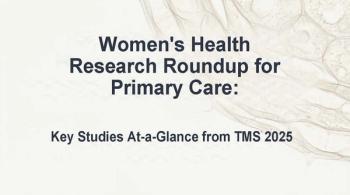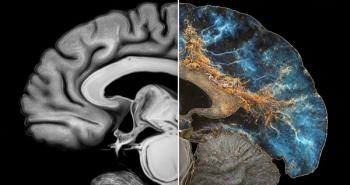Real-World Memory Clinic Data Suggest Lecanemab Use Is Feasible, Practical for Adults with Alzheimer Disease
Adults with early AD who were treated with lecanemab in a specialty memory clinic experienced adverse events comparable to those seen in clinical trials.
In one of the first real-world analyses of lecanemab use outside a controlled trial setting, researchers from Washington University’s Memory Diagnostic Center (MDC) report that treatment with the anti-amyloid antibody (AAA) is both feasible and generally well tolerated in a specialty memory clinic population. The retrospective cohort study, published in JAMA Neurology, found that the rate of amyloid-related imaging abnormalities (ARIA)—a key safety concern with this drug class—was comparable to or moderately higher than rates observed in pivotal phase 3 clinical trials but largely manageable in practice.1
Lecanemab is 1 of 2 monoclonal antibodies targeting amyloid plaques approved by the FDA for treatment of early symptomatic Alzheimer disease (AD). Infusion-related reactions and ARIA, with edema/effusion (ARIA-E) or and/or with hemorrhage/hemosiderin deposition (ARIA-H) are the most significant adverse events (AEs) associated with the IV-delivered AAAs.2
"As anti-amyloid antibodies move from clinical trials, where rigorous inclusion/exclusion criteria are applied and safety and monitoring protocols are closely followed, to clinical practice, where clinical judgement may widen inclusion criteria and protocols may be less rigorously followed, the safety of treatments must be carefully examined," lead author Barbara Joy Snider, MD, PhD, professor of neurology, and director of the MDC and Knight ADRC Clinical Trials Unit, Washington University School of Medicine, St. Louis, Missouri, and colleagues wrote.1
Snider and colleagues evaluated 234 adults with early AD who initiated lecanemab infusions (10 mg/kg intravenous every 2 weeks) in the memory clinic between August 2023 and October 2024.
The researchers reported that during the average treatment period of 6.5 months, 22% of those receiving at least 4 infusions of lecanemab and 1 follow-up MRI developed ARIA. Of these, 15% had ARIA-E and 6.7% developed isolated ARIA-H. Symptomatic ARIA occurred in 5.7% of patients, and only 2 patients (1.0%) experienced clinically severe symptoms requiring hospitalization. Importantly, no macrohemorrhages or treatment-related deaths were observed, according to the study.
Infusion-related reactions occurred in 37% of patients, mostly during the first 2 doses and generally mild to moderate in severity, the authors said. After implementing a protocol to pretreat patients with acetaminophen and loratadine, the rate dropped to 27%. According to the study, 5 participants (2.1%) experienced more severe or atypical infusion reactions, including transient neurologic symptoms or rash. There were no study discontinuations related to life-threatening events.1
Snider et al noted that the study cohort, older on average than participants in the pivotal CLARITY-AD trial (mean age 74.4 vs 71.4 years), also had lower mean Mini-Mental State Examination (MMSE) scores (24 vs 26). Approximately half were women and nearly all all were White. APOE ε4 carriage—a known risk factor for ARIA—was present in 61% of participants who were genotyped, including 8.5% who were homozygous. Of those who developed ARIA-E, 38% were ε4 homozygotes.
Overall, 23 patients (9.8%) stopped treatment. Ten withdrawals were due to ARIA (4.3%), while others cited infusion-related symptoms, intolerance of MRI scans, or logistical challenges. The majority of ARIA cases were asymptomatic and detected through routine MRI monitoring, which the clinic implemented at standardized intervals.
While the ARIA rate appeared higher than that reported in CLARITY-AD (22% vs 12.6% for ARIA-E), the authors emphasized that the real-world patient population was more heterogeneous and less stringently selected than in clinical trials.
Patients with mild dementia at baseline (Clinical Dementia Rating [CDR], 1) had a 15-fold higher risk of symptomatic ARIA compared to those with mild cognitive impairment or very mild dementia (CDR, 0.5) (27% vs 1.8%, P <.001).
Baseline MMSE scores were lower in those who developed symptomatic ARIA (mean 19 vs 24), and APOE ε4 homozygosity conferred a significantly elevated risk. Still, 76% of patients with ARIA remained on treatment, and most symptomatic cases resolved with treatment interruption and close follow-up.1
Snider and colleagues said their findings point toward a strong association between risk of ARIA and severity of clinical symptoms, a link they suggested could be related to the "increasing burden of cerebral amyloid angiopathy with advancing AD." Moreover, such a relationship underscores "the importance of diagnosing and treating symptomatic AD as early as possible," they wrote.1
The study authors concluded that, despite the complexity of lecanemab therapy—including the need for biomarker confirmation, infusion scheduling, and imaging surveillance—real-world implementation in a specialized setting is practical.
"As experience with anti-amyloid antibody treatments increases and new strategies are further developed, we expect that more efficient and generalizable care pathways will be created and implemented," they concluded.1
References
1. Paczynski M, Hofmann A, Posey Z, et al. Lecanemab treatment in a specialty memory clinic. JAMA Neurology. Published online May 12, 2025. doi:10.1001/jamaneurol.2025.1232
2. van Dyck CH, Swanson CJ, Aisen P, et al. Lecanemab in early Alzheimer’s disease. N Engl J Med. 2023;388(1):9-21. doi:10.1056/NEJMoa2212948
Newsletter
Enhance your clinical practice with the Patient Care newsletter, offering the latest evidence-based guidelines, diagnostic insights, and treatment strategies for primary care physicians.



















































































































































































































































































